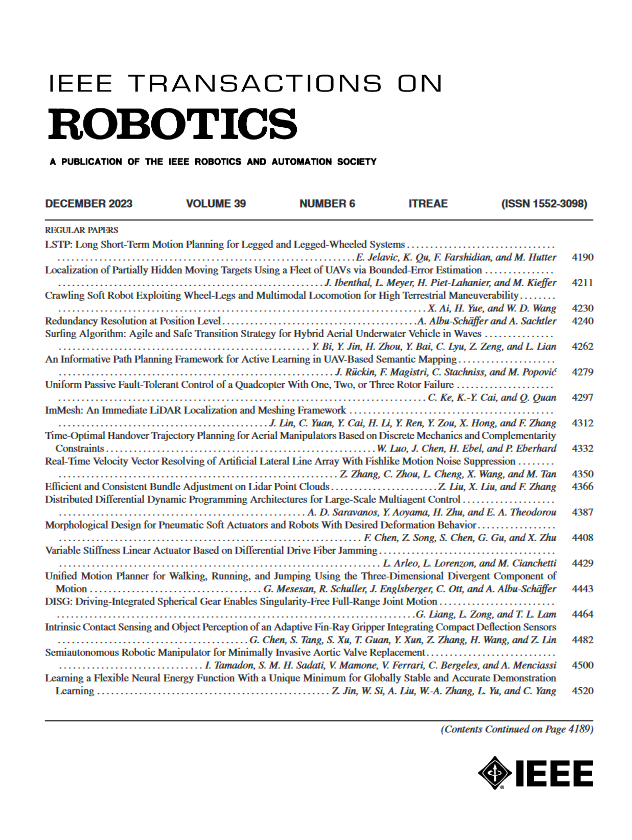Fourigami: A 4-Degree-of-Freedom, Force-Controlled, Origami, Finger Pad Haptic Device
IF 10.5
1区 计算机科学
Q1 ROBOTICS
引用次数: 0
Abstract
Skin deformation haptic devices worn on the finger pad provide realistic touch feedback during interactions with virtual objects. Two primary challenges in creating such devices are: first, making a multidegree-of-freedom device (DoF) that is small and lightweight so it does not encumber the wearer and second, providing accurate control of forces displayed to the finger pad. This work presents a 4-DoF finger pad haptic device, called Fourigami, that addresses these challenges. We address the first challenge using origami manufacturing methods and pneumatic actuation to fabricate a 25 g prototype that displays normal, shear, and twist and can be easily worn on the finger pad. We address the second challenge using a low-profile, 6-DoF, force/torque sensor to control forces displayed to the finger. Fourigami has a bandwidth ranging from 2 to 4 Hz depending on direction, and when acting on a human finger, it exerts forces ranging fromFourigami:一个四自由度,力控制,折纸,手指垫触觉设备
佩戴在指垫上的皮肤变形触觉装置在与虚拟物体交互时提供真实的触摸反馈。制造这种装置的两个主要挑战是:首先,制造一个小而轻的多自由度装置(DoF),这样它就不会妨碍佩戴者;其次,提供对手指垫显示的力的精确控制。这项工作提出了一种名为Fourigami的四自由度手指触控设备,解决了这些挑战。我们使用折纸制造方法和气动驱动来解决第一个挑战,制造了一个25克的原型,可以显示正常,剪切和扭曲,并且可以很容易地佩戴在指垫上。我们使用一个低调的,6自由度,力/扭矩传感器来控制显示在手指上的力来解决第二个挑战。根据方向,Fourigami的带宽从2到4 Hz不等,当作用在人的手指上时,它施加的力范围为$\pm$ 1.0 N的剪切力,4.2 N的法向力和$\pm$ 4.2 N $ cdot$ mm的扭转力。最后,我们展示了该设备在向用户呈现触觉反馈时的功效,该用户跟踪正弦轨迹和表示与虚拟对象交互的轨迹。
本文章由计算机程序翻译,如有差异,请以英文原文为准。
求助全文
约1分钟内获得全文
求助全文
来源期刊

IEEE Transactions on Robotics
工程技术-机器人学
CiteScore
14.90
自引率
5.10%
发文量
259
审稿时长
6.0 months
期刊介绍:
The IEEE Transactions on Robotics (T-RO) is dedicated to publishing fundamental papers covering all facets of robotics, drawing on interdisciplinary approaches from computer science, control systems, electrical engineering, mathematics, mechanical engineering, and beyond. From industrial applications to service and personal assistants, surgical operations to space, underwater, and remote exploration, robots and intelligent machines play pivotal roles across various domains, including entertainment, safety, search and rescue, military applications, agriculture, and intelligent vehicles.
Special emphasis is placed on intelligent machines and systems designed for unstructured environments, where a significant portion of the environment remains unknown and beyond direct sensing or control.
 求助内容:
求助内容: 应助结果提醒方式:
应助结果提醒方式:


